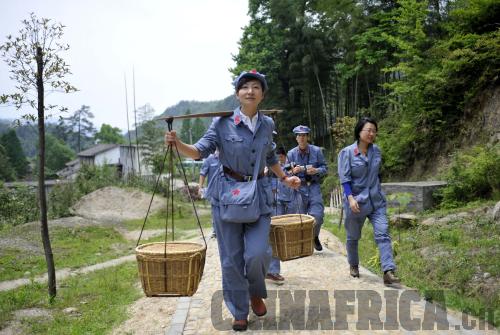|
 |
|
GETAWAY: Tourists flock to Jinggangshan, the cradle of the Chinese revolution XINHUA |
Han Yongyi believes that the most memorable summer vacation he has experienced happened in 2011. In July the 29-year-old teacher from Shanghai embarked on a weeklong trip to some of China's revolutionary sites in Jiangxi Province, a renowned revolution-era base in China. The trip, organized by his university, was to mark the 90th anniversary of the Communist Party of China (CPC).
"I am educated [on this trip]," said Han. "I have watched documentary films on the evolution of the Party, put on the military uniform, and ate the army food. This gave me an authentic experience of living in those years. I can understand the hard times our grandfathers went through in fighting for today's happier life."
Millions of Chinese, like Han and his colleagues, are visiting red scenic spots across China to revive the old memories of the revolutionary years.
Red legacy
Red tourism has become a catchword in China nowadays. It is a name given to the industry that has sprung up around sites associated with the Chinese revolution.
This year, the whole red tourism market has been stimulated by the enthusiasm to commemorate the Party's birthday, according to Zheng Nianjun from the Guangzhou-based Nanhu Travel Agency.
Zheng said that red tourism is now a hot topic. The number of the agency's red tour customers has seen a four-fold increase in July compared to the same period last year.
"If you want to go to Jinggangshan [the 1930s Red Army base and start of the Long March (1934-36) in Jiangxi Province] recently, you may have to consider another route," said Wen Shuang, General Manager of the Bureau of Domestic Tourism with GZL International Travel Service. "The majority of our classic routes to red tourism spots, including Jinggangshan, Yan'an [end of the Long March in Shaanxi Province], Xibaipo Village [the commanding headquarters of the CPC and its troops from 1948 to 1949 in Hebei Province], are fully booked until the end of August."
As well as visits to traditional sites such as Jinggangshan and Yan'an, some long-distance tour packages to Chongqing Municipality, Sichuan, Guizhou and Hainan provinces have become increasingly popular.
Wen said many government organizations, enterprises and institutions have organized incentive tourism for their employees. Red scenic spots, combining patriotic education and recreation, have become a good choice.
Economic draw card
Now more than spiritual assets, red tourism is a source of economic potential.
In 2010 alone, the red scenic spots in Jiangxi saw more than 43 million tourists, a 22 percent increase from 2008, with tourism revenues amounting to about 32.7 billion yuan ($5 billion). This accounted for about 3.5 percent of the provincial GDP, according to statistics provided by local government. At the same time, the industry has employed 180,000 people and indirectly created 900,000 jobs.
To accommodate the increasing numbers of tourists flocking to the cradle of the Chinese revolution, the provincial government has put more than 600 million yuan ($93 million) into infrastructure at 18 major red scenic spots.
Thanks to the improved environment and service facilities, local villages have reaped many benefits from the red tourism industry.
Guo Haibao, a former migrant worker, now runs a family restaurant next to the highway under Jinggangshan Mountain.
According to Guo, the number of visitors has increased dramatically since last year, as the local government has built the highway and railway to promote the red tourism industry.
"I never expected such good business. It is encouraging. I have already opened my first branch this year," said the local resident, with a sense of pride, revealing that he earned a 7-figure income last year.
Guo is not alone in his attempts to make money from red tourism. Throughout the country, red tourism has transformed many of the economically backward former revolutionary bases into a new era of economic development and has given locals a better life.
|